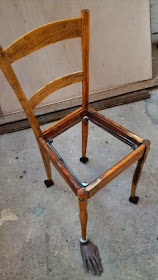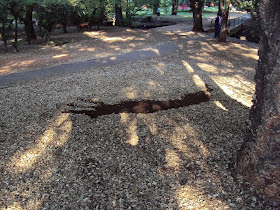..jpg) |
Ann-Marie Tully, Let sleeping dogs lie: George, 2011. Gesso & oil on Fabriano. 700mm x 1000mm.
The Johannesburg Art Gallery collection.
|
Wednesday, 31 December 2014
George goes to JAG!
Ornamental animal stackings ...
 |
| Ann-Marie Tully, Bambi & family forever. Ceramic assemblage. |
 |
| Ann-Marie Tully, Herding Cats. Ceramic assemblage. |
 |
| Ann-Marie Tully, Herding Cats. Ceramic assemblage. |
 |
| Ann-Marie Tully, Bambi & family forever. Ceramic assemblage. |
 |
| Ann-Marie Tully, Bambi & family forever. Ceramic assemblage. |
 |
| Ann-Marie Tully, Bambi & family forever. Ceramic assemblage. |
 |
| Ann-Marie Tully, Bambi & family forever. Ceramic assemblage. |
 |
| Ann-Marie Tully, Bambi & family forever. Ceramic assemblage. |
 |
| Ann-Marie Tully, Bambi & family forever. Ceramic assemblage. |
A dog's breakfast
 |
| Ann-Marie Tully, A dog's breakfast: Naval officer and dog, Graspan. Oil on enamelware. 200mm diameter. |
 |
| Ann-Marie Tully, A dog's breakfast: Nurse, Transvaal hospital train & howling dog. Oil on enamelware. 200mm diameter. |
 |
Ann-Marie Tully, A dog's breakfast: General Lord Kitchener of Kartoum.
Oil on enamelware. 220mm diameter.
|
Rebel dogs
 |
| Ann-Marie Tully, Rebel dogs I (detail). Oil on paper. 345mm x 345mm. |
 |
| Ann-Marie Tully, Rebel dogs II (detail). Oil on paper. 345mm x 345mm. |
 |
| Ann-Marie Tully, Rebel dogs III (detail). Oil on paper. 345mm x 345mm. |
 |
| Ann-Marie Tully, Rebel dogs I. Oil on paper. 345mm x 345mm. |
| Ann-Marie Tully, Rebel dogs II. Oil on paper. 345mm x 345mm. |
Monday, 29 December 2014
Lyuba @ the end
 |
Ann-Marie Tully, Lyuba at the end I, 2014. Ink and bleach on paper. 230 x 230 mm.
|
 |
Ann-Marie Tully, Lyuba at the end II, 2014. Ink and bleach on paper. 230 x 230 mm.
|
 |
Ann-Marie Tully, Lyuba at the end III, 2014. Ink, bleach, cotton on paper. 250 x 350 mm.
|
 |
| Ann-Marie Tully, Lyuba at the end IV, 2014. Ink, bleach, cotton on paper. 250 x 350 mm. |
In
2007, the remarkably preserved carcass of a female baby mammoth named
"Lyuba" was discovered near the Yuribei River in Siberia, where it
had been buried for 41,800 years.[1] By cutting a section through a molar and analysing its growth lines, they found
that this creature had died at the age of one month.[2] The
mummified calf weighs 50 kg, is 85 cm high and 130 cm long.[3]
At the time of discovery, her eyes and trunk were intact and some fur remained
on her body, while her organs and skin were very well preserved.[4]
An important aspect of Lyuba’s story is how she was discovered and named by a
Nenets reindeer herder called Yuri Khudi. Nenets view mammoths as dangerous
omens. Despite these pervasive mythical beliefs, Khudi vowed to placate the
infernal powers with the sacrifice of a baby reindeer and a libation of vodka.
Following some difficulties, Lyuba’s body was packed and shipped by helicopter
to the safety of the Shemanovsky Museum in Salekhard, the regional capital.
Grateful officials named her “Lyuba”, after Khudi’s wife, a name that means
‘love’.[5]
The
body of work, Lyuba at the end
employs Lyuba’s story as a analogous springboard for the consideration of
related concepts: the ancient and contemporary relations of humans and animals
– including predacious patterns of behavior; rhetorical and totemic “magical” practices and beliefs extending into the deep time of human existence; and the familiar, but ancient reach of loving/respectful inter-species relations, that in the case of
domesticated animals is often juxtaposed by predacious necessity. While not domestic animals, there can be no doubt that mammoths were revered creatures in palaeolithic human reckoning: significant as both prey and totemic figures.
The figure of
Lyuba also reminds us of each beings shared mortality - a levelling notion. Lyuba's frozen end during the last ice age can also serve as a metaphor for humanity’s current disaffected and problematic relationship with the
earth, which is now again in a state of climate flux affected (at least in part) by rampant human industry. The significance of tusked and horned animals (elephants, antelope, rhinoceros
etc) in ancient and contemporary consumption
(poaching for 'medicinal' use) is also reflected upon.
[1] Kosintsev,
P. A.; Lapteva, E. G.; Trofimova, S. S.; Zanina, O. G.; Tikhonov, A. N.; Van
Der Plicht, J. 2012. "Environmental reconstruction inferred from the
intestinal contents of the Yamal baby mammoth Lyuba (Mammuthus primigenius
Blumenbach, 1799)". Quaternary International 255: 231.
[2] Rountrey,
A. N.; Fisher, D. C.; Tikhonov, A. N.; Kosintsev, P. A.; Lazarev, P. A.;
Boeskorov, G.; Buigues, B. 2012. "Early tooth development, gestation and
season of birth in mammoths". Quaternary International 255: 196.
[3] Rincon,
P. 2007. "Baby mammoth discovery unveiled". BBC News. [O]. http://www.reuters.com/article/scienceNews/idUSL1178205120070711
Retrieved 13 July 2012.
[4] Smith,
O. (21 April 2009). “Baby Mammoth Lyuba”. Daily News (New York). [O]. http://www.nydailynews.com/news/us_world/2009/04/21/2009-04-21_baby_mammoth_lyuba_pristinely_preserved_offers_scientists_rare_look_into_mysteri.html
Retrieved 10 September 2012.
[5] “Ice baby”, 2009. [O]. http://ngm.nationalgeographic.com/2009/05/mammoths/mueller-text
Retrieved 17 August 2013.
Ball and claw (hybrid) I - a prototype ...
 |
| Ann-Marie Tully, Ball and claw (prototype), 2014. Found chair, 'grafted' ball and claw feet, mannequin hand. |
 |
Ann-Marie Tully, Ball and claw (prototype) (detail), 2014. Found chair, 'grafted' ball and
claw feet, mannequin hand.
|
This is a prototype for a series of sculptural furniture pieces I want to continue with that draw attention to just how weird the 'ball and claw' motif is: dismembered animal claws/paws supporting tables and chairs, propping up our human pursuits - a decorative device in keeping with humanity's exploitation of, and cruelty towards non-human life and the environment!
I am interested in how swopping out the generalised animal claws for clenched human hands (and other related positions) would shift the hierarchical paradigm; also conjuring up histories where 'Other' groups of humans have been rendered to the level of 'animal support' for more 'privileged' groups - the differentiation of which is sketched along the same lines as animal/human difference.
This is a prototype because the mannequin hand is not seamless enough with the chair or the furniture genre. My next step is to do castings of my own hands in 'ball and claw' positions. What was successful in my view was the 'grafting' of ball and claws from another piece onto this simple chair. There is a violence in the gesture that needs to be continued in all the pieces ...
This chair was included in Gordon Froud's Cathedra (Chair) exhibition, which toured 2014, continuing in 2015:
Sunday, 2 November 2014
Wednesday, 27 August 2014
'The Waterlogged Infanta' (From 'The Elemental Infantas' series)
 |
|
Ann-Marie Tully, The
Waterlogged Infanta (The Elemental
Infanta series), 2014. Ceramic,
cobalt
oxide, mirror, glass dome. (H) 120mm x (W)
130mm x (D) 100mm.
|
 |
Ann-Marie Tully, The Waterlogged Infanta (The Elemental Infanta series), 2014. Ceramic,
cobalt oxide, mirror, glass dome. (H) 120mm x (W) 130mm x (D) 100mm.
|
 |
Ann-Marie Tully, The Waterlogged Infanta (The Elemental Infanta series), 2014. Ceramic,
cobalt oxide, mirror, glass dome. (H) 120mm x (W) 130mm x (D) 100mm.
|
 |
Ann-Marie Tully, The Waterlogged Infanta (The Elemental Infanta series), 2014. Ceramic,
cobalt oxide, mirror, glass dome. (H) 120mm x (W) 130mm x (D) 100mm.
|
 |
Ann-Marie Tully, The Waterlogged Infanta (The Elemental Infanta series), 2014. Ceramic,
cobalt oxide, mirror, glass dome. (H) 120mm x (W) 130mm x (D) 100mm.
|
 |
Ann-Marie Tully, The Waterlogged Infanta (The Elemental Infanta series), 2014. Ceramic,
cobalt oxide, mirror, glass dome. (H) 120mm x (W) 130mm x (D) 100mm.
|
 |
Ann-Marie Tully, The Waterlogged Infanta (The Elemental Infanta series), 2014. Ceramic,
cobalt oxide, mirror, glass dome. (H) 120mm x (W) 130mm x (D) 100mm.
|
 |
Ann-Marie Tully, The Waterlogged Infanta (The Elemental Infanta series), 2014. Ceramic,
cobalt oxide, mirror, glass dome. (H) 120mm x (W) 130mm x (D) 100mm.
|














